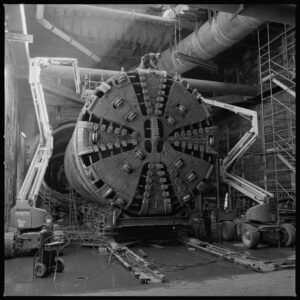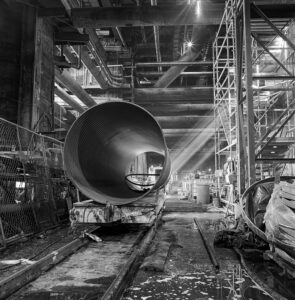Ken Karagozian’s mesmerizing tunnel photographs reveal the captivating essence of underground construction’s unique subculture.
by Patricia Schallert
 Ventura resident Ken Karagozian was born and raised in Woodland Hills. He studied photography in high school and worked at ABC/Disney Studios in Hollywood. When Ken first ventured into fine art photography, he initially focused on capturing the beauty of landscapes. However, his workshop instructors, including John Sexton, assistant to the late Ansel Adams, Bruce Barnbaum, and Ray McSavaney, suggested he start a project closer to home. Inspired by their advice, he embarked on his first project: capturing the vibrant atmosphere of buyers and sellers at the Pasadena Rose Bowl Flea Market. To his delight, his work received recognition and was published in Pasadena Magazine.
Ventura resident Ken Karagozian was born and raised in Woodland Hills. He studied photography in high school and worked at ABC/Disney Studios in Hollywood. When Ken first ventured into fine art photography, he initially focused on capturing the beauty of landscapes. However, his workshop instructors, including John Sexton, assistant to the late Ansel Adams, Bruce Barnbaum, and Ray McSavaney, suggested he start a project closer to home. Inspired by their advice, he embarked on his first project: capturing the vibrant atmosphere of buyers and sellers at the Pasadena Rose Bowl Flea Market. To his delight, his work received recognition and was published in Pasadena Magazine.
One day, while driving along Hollywood Boulevard, Ken stumbled upon an abandoned car wash. Curiosity took hold of him as he saw a massive fence around the car wash with a sign indicating a federally funded Metro Transportation Construction Project. Fascinated, Ken decided to inquire with the MTA in the early 1990s regarding permission to photograph the construction. After patiently waiting, he received a favorable response, granting him a single day to capture the essence of the project. Excited at the opportunity, Ken described feeling “like I was riding a Disneyland train.” This single day marked the start of an extraordinary three-decade-long journey documenting the Los Angeles underground transportation system, including the monumental task of capturing the rebuilding of the iconic Sixth Street Bridge.
During his time photographing the Metro Red Line, Ken often heard stories from construction workers about the media frenzy surrounding O.J. Simpson. Interestingly, the construction of the Metro Red Line along Hollywood Boulevard seemed to be the second most talked-about topic at the time. Inspired by this narrative, Ken decided to incorporate it into his photography, starting with images of construction workers’ gloves.
Embarking on a lifelong journey, Ken has dedicated himself to capturing the captivating essence of a one-of-a-kind subculture through his mesmerizing tunnel photographs. He found himself irresistibly drawn to the depths of the underground, where he descends an impressive 50 to 75 feet. The sheer enchantment of being in a space that so few have had the privilege to explore fills him with wonder. As tunnel crews uncover ancient fossils and Ken witnesses the remarkable discoveries of diligent workers and brilliant paleontologists, he explains that he can’t help but feel a profound sense of gratitude. He treasures the unique privilege of immersing himself in a world where an ancient ocean once thrived silently beneath the bustling streets of Hollywood Boulevard. The enormity of this fact never fails to leave him in awe.
 Ken’s award winning photography has been widely exhibited locally and nationally, and has been featured in many publications, including LIFE Magazine, the Los Angeles Times, and Pasadena Magazine. Currently, his photo projects focus on photographing the depths below Wilshire Boulevard, which Ken explains “presents its own set of challenges for the construction workers due to the presence of gas and tar underground.” Being mindful of his surroundings is crucial, especially with the presence of heavy construction equipment. Thankfully, his hard hat has come to his rescue on a few occasions, protecting him from accidental head bumps on structural support beams.
Ken’s award winning photography has been widely exhibited locally and nationally, and has been featured in many publications, including LIFE Magazine, the Los Angeles Times, and Pasadena Magazine. Currently, his photo projects focus on photographing the depths below Wilshire Boulevard, which Ken explains “presents its own set of challenges for the construction workers due to the presence of gas and tar underground.” Being mindful of his surroundings is crucial, especially with the presence of heavy construction equipment. Thankfully, his hard hat has come to his rescue on a few occasions, protecting him from accidental head bumps on structural support beams.
Continuously seeking unique perspectives and different lighting conditions, Ken is “perpetually searching for that one photograph that captures the essence of the subculture from angles and lighting never explored before.” Through his photographs of the underground metro, he hopes viewers gain an appreciation for the complexity and laborious nature of this work. Witnessing the skill and precision of miners as they navigate tunnel boring machines and achieve exact “hole through” moments when entering a station is truly astonishing. Ken also noted that when he first began documenting the Hollywood Red Line, there were only a few women in construction roles. However, today there is an increasing presence of women as electricians, carpenters, ironworkers, and engineers. As the stations are built, those women and men serve as connections linking the LA metro’s diverse communities. Ken’s ultimate hope is to learn from and appreciate the richness of all ethnicities within our beautiful cities in California. He loves the “human interest” part of the project. “If it wasn’t for the workers, we would not have this subway construction in Los Angeles,” he continues, adding, “So, I’m really indebted to the men and women that are building Los Angeles’ future transportation and enjoy when my work is on display. Seeing the reactions of the viewers to my tunnel photography, where the tunnel is seen to go into infinity, is fascinating and rewarding.”
“I never know what I’ll photograph upon entering the construction site. I try to visit each site about twice a month. The progress keeps changing underground. The lighting can be very dramatic in the tunnels or you may even get sun rays entering from above ground.”
